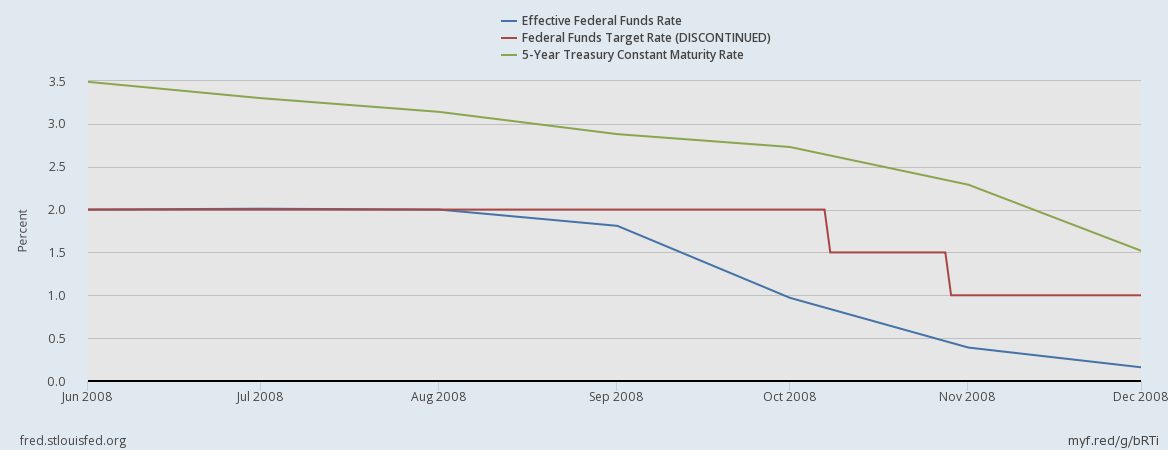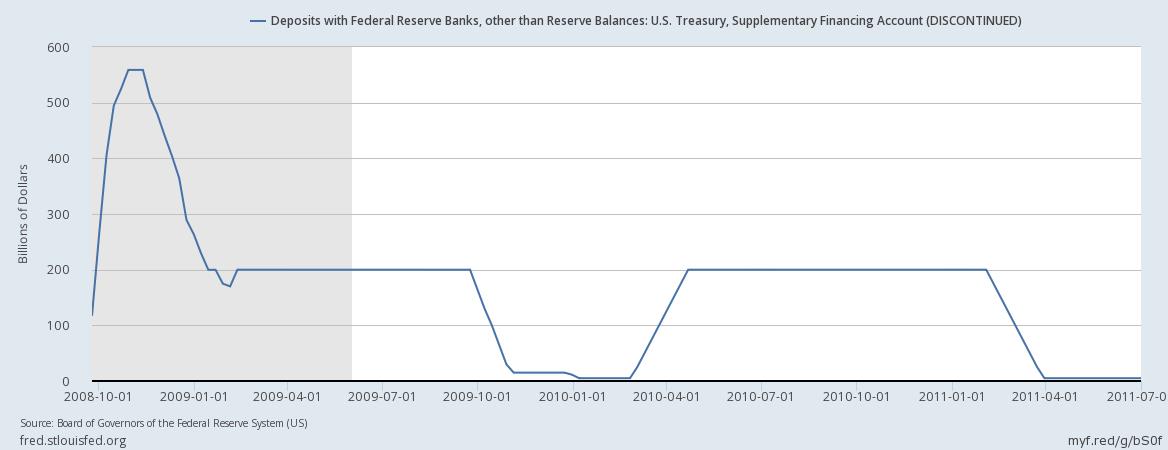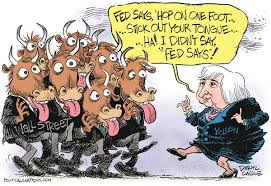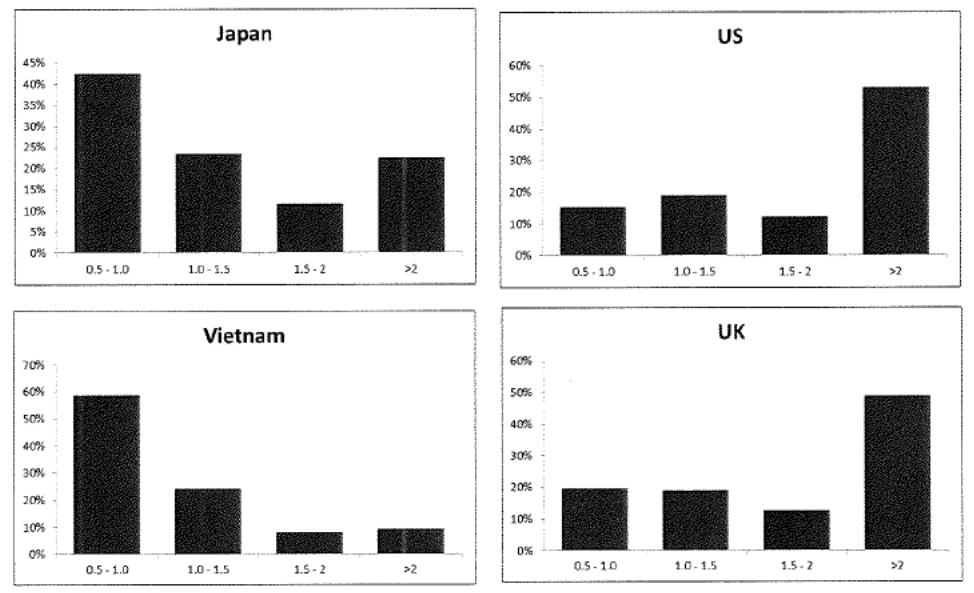Source: https://www.alt-m.org/2016/12/01/fed-holding-interest-rates/
ONCE UPON A TIME, when my twin brother and I were tots, our father convinced us that he could make a traffic light change from red to green whenever he wanted it to. Raising his hand to the light as we sat at an intersection, he would say, “I command you to change to green….now!” cocking his finger at the light for emphasis. Sure enough, the light would change precisely on cue, while two little boys shouted, “Papa, how do you do that!?”
I share this little anecdote because I’m convinced that, if more people had been fooled the way my brother and I were, fewer would be so gullible today as to believe that the Fed has been firmly in control of interest rates these past eight years, and that it is only owing to that control that rates have remained low for so long.
The view that the Fed might have raised interest rates long ago, had it only wanted to, became notorious during the presidential campaign, when Donald Trump publicly accused Janet Yellen’s Fed of keeping rates low for political reasons. But Trump was merely embroidering a belief common among many (mostly conservative) Fed critics. Writing for Project Syndicate this June, Carmen Reinhart observed that “The US Federal Reserve led the charge among central banks…by relying on a near-zero policy rate … interest rates have been low, and remain low, because policymakers have gone to great lengths to keep them there.” In a March 2015 Wall Street Journalop-ed, David Malpass attacked “The Fed’s belief that near-zero rates lead to growth.” “Private sector dynamism,” he noted, “thrives on market pricing, not artificially low rates.” Similar opinions were expressed by several speakers at the Cato’s recent Annual Monetary Conference.
Indeed, the myth that interest rates have been held down by the Fed’s easy monetary policies has been given credence by Fed officials themselves. Their intent, to be sure, hasn’t been to fault the Fed. They’re merely loath to admit that rates haven’t been fully, or almost fully, under its control. Hence Yellen’s bland reply to Trump, that “partisan politics plays no role in our decisions about the appropriate stance of monetary policy.” That, to a Fed bureaucrat, is safer than saying, “Keeping rates low? Why, we only wish we could raise them!”
Fed Vice-Chair Stanley Fischer displayed unusual candor, on the other hand, in addressing the Economic Club of New York recently. “I am sure,” Fischer said,
that the reaction of many of you may be, “Well, if you and your Fed colleagues dislike low interest rates, why not just go ahead and raise them? You are the Federal Reserve, after all.” One of my goals today is to convince you that it is not that simple, and that changes in factors over which the Federal Reserve has little influence — such as technological innovation and demographics — are important factors contributing to both short- and long-term interest rates being so low at present.
Yet even Fischer, later in that same speech, reverted to the standard suggestion that the Fed was firmly in the saddle. “But, of course,” he said, “Fed interest rates are kept very low at the moment because of the need to maintain aggregate demand at levels that will support the attainment of our dual policy goals of maximum sustainable employment and price stability, defined as the rate of inflation in the price level of personal consumption expenditures (or PCE) being at our target level of 2 percent.”
The unvarnished truth, I hope to persuade you, is that interest rates have been low since the last months of 2008, not because the Fed has deliberately kept them so, but in large part owing to its misguided attempt, back in 2008, to keep them from falling in the first place.
How Rates Got Down
Far from having endeavored, back then, to lower interest rates, Fed officials feared that, as rates approached their “zero lower bound,” monetary policy would cease to be effective. Although it’s true that during October 2008 the FOMC lowered its federal funds rate target, first from 2 percent (where it had been since the end of April) to 1.5 percent, and finally to 1 percent, it made these changes reluctantly, and did so in each case after the effective funds rate (the median value of actual overnight loan rates) fell well below the targets already in place. Longer-term interest rates likewise fell in advance of the Fed’s target changes, as can be seen from the chart below, which compares the Fed’s funds-rate target to both the effective federal funds rate and the yield on 5-year Treasury Notes. In few words, by the time the Fed got around to lowering it, the federal funds target had ceased to have any meaning, save as a symbol of Fed officials’ vain hopes.
That market rates were in decline before the Fed lowered its policy target is only one of several reasons why it makes little sense to attribute their decline, or their initial decline at least, to “easy” monetary policy. A second is that an easy policy stance ought, ipso facto, to have led to an eventual increase in nominal spending, if not in the rate of inflation. Yet, as everyone knows, neither of those things happened. Instead, as the next chart shows, both headline and core PCE inflation rates fell, and continued to do so for the better part of a year, while the rate of growth of nominal GDP, which had already been declining for some months, fell to below minus 3 percent, and did not begin to recover until July of 2009.
Why Quantitative Easing Didn’t Hold Them There
What about Quantitative Easing? Surely, one might think, the Fed’s large-scale purchases of mortgage-backed and Treasury securities between late November 2008 and October 2014 marked a decisive turn toward easy monetary policy, and hence a source of downward pressure on interest rates. After all, Ben Bernanke himself held that quantitative easing — or what he preferred to refer to as the Fed’s “Large Scale Asset Purchases” — was aimed at lowering long term yields:
Federal Reserve purchases of mortgage-backed securities (MBS), for example, should raise the prices and lower the yields of those securities; moreover, as investors rebalance their portfolios by replacing the MBS sold to the Federal Reserve with other assets, the prices of the assets they buy should rise and their yields decline as well. Declining yields and rising asset prices ease overall financial conditions and stimulate economic activity through channels similar to those for conventional monetary policy.
What’s more, Bernanke claimed that LSAPs had reduced yields in fact:
After nearly four years of experience with large-scale asset purchases, a substantial body of empirical work on their effects has emerged. Generally, this research finds that the Federal Reserve’s large-scale purchases have significantly lowered long-term Treasury yields. For example, studies have found that the $1.7 trillion in purchases of Treasury and agency securities under the first LSAP program reduced the yield on 10-year Treasury securities by between 40 and 110 basis points. The $600 billion in Treasury purchases under the second LSAP program has been credited with lowering 10-year yields by an additional 15 to 45 basis points. Three studies considering the cumulative influence of all the Federal Reserve’s asset purchases, including those made under the MEP, found total effects between 80 and 120 basis points on the 10-year Treasury yield. These effects are economically meaningful.
If the Fed’s critics needed a smoking gun to cinch their case that the Fed deliberately kept rates down, surely this is it!
But once again, things aren’t so simple. First of all, the Fed’s purchases represented an obvious easing of monetary policy only in a ceteris paribus sense. Whether massive increases in the nominal quantity of base money amounted to “easy” monetary policy in practice depended on concurrent movements in the real demand for base money. In fact, the demand for base money kept pace with the supply, in part owing to other Fed-orchestrated policy steps. Those steps included the Treasury’s Supplementary Financing Program (SPF), begun in mid-September 2008, and the Fed’s October 8, 2008 decision to begin paying interest on banks’ excess reserves. Their aim was to get banks and the government to park more cash at the Fed, and to thereby assist it in meeting its fed funds target, by preventing the Fed’s asset purchases from contributing to any increase in the supply of overnight funds. At one point, as the next chart shows, the SPF program alone immobilized almost $559 billion in base money, preventing it from serving as a basis for private-sector money creation.
As for interest on reserves, although it failed to establish an above-zero “lower bound” on the effective federal funds rate, as Fed officials originally hoped it would, the policy did succeed, in combination with the ongoing decline in market rates, in getting banks to hoard reserves instead of swapping them for interest-earning assets. The IOER rate has, for most of its existence, exceeded yields on most Treasury securities, allowing foreign banks in particular to profit by arbitraging the difference between the two rates, and making a general preference for reserves over Treasuries as means for meeting new regulatory liquidity needs a no-brainer.
For these and other reasons, the Fed’s unprecedented asset purchases, which might ordinarily have been expected to result in roughly proportional increases in broad money, spending, inflation, and nominal interest rates, affected those variables only modestly, if at all, and did so for the most part by limiting their tendency to decline, rather than by raising them in an absolute sense.
And what about the “significant declines in the yields on both corporate bonds and MBS” Bernanke refers to? Don’t they prove that, despite the hoarding of base money, quantitative easing did in fact reduce interest rates, at least on longer-term securities? Well, yes and no. The empirical evidence to which Bernanke refers is anything but clear-cut. Besides the wide range in the estimates (which some other studies make even wider), the studies suggest that of the several rounds of asset purchases, QE1 alone succeeded in lowering long-run yields generally, and not just on the assets the Fed purchased. More importantly, the estimated reductions were short-run reductions only, with estimated durations of as little as a few months, and no more than a bit over two years. That’s not long enough to account for the fact that rates remain low, despite a recent uptick, to this day.
But don’t take my word on that last point. Instead hear our star witness again, on the Fed’s long-run influence on rates:
If you asked the person in the street, “Why are interest rates so low?”, he or she would likely answer that the Fed is keeping them low. That’s true only in a very narrow sense. The Fed does, of course, set the benchmark nominal short-term interest rate. The Fed’s policies are also the primary determinant of inflation and inflation expectations over the longer term, and inflation trends affect interest rates, as the figure above shows. But what matters most for the economy is the real, or inflation-adjusted, interest rate…. The Fed’s ability to affect real rates of return, especially longer-term real rates, is transitory and limited. Except in the short run, real interest rates are determined by a wide range of economic factors, including prospects for economic growth — not by the Fed.
In other words, if QE — sorry, LSAPs — worked as Bernanke (2012) claims, it did so, according to Bernanke (2016), only temporarily. If the purchases appeared to do more than that, it was because they anticipated rate changes already in the cards, including ones symptomatic of the very same faltering recovery that informed the Fed’s decision to engage in large-scale asset purchases in the first place. As Mehmet Pasaogullari puts it (in a paper written for the Cleveland Fed last year), “each round of QE should be viewed as a response to very unfavorable economic conditions at a time when further stimulus to the economy could not be provided by means of the federal funds rate because of the zero lower bound.” LSAPs were, in still other words, the Fed’s way of pointing at sagging interest rates and saying, “I command you to change…now!”
But why trust Bernanke (2016)? We should trust him because both (relatively) tried and true theory (as opposed to the dubious theories that informed Quantitative Easing itself), and the empirical record, agree with him. The tried and true theory is, of course, Knut Wicksell’s. As Larry White observed, in addressing the topic of low interest rates here in July,
In Wicksell’s famous and now-standard analysis, a central bank can drive (or hold) the market rate of interest below the natural rate by injecting money, which shifts the supply of loanable funds curve to the right, increasing the quantity of loanable funds and lowering the interest rate (the “liquidity effect”). As the new money circulates it drives up prices and nominal incomes, however, which shifts the nominal demand for loanable funds curve to the right, raising the market interest rate (the “nominal income effect”). If the central bank wants to keep the market rate low in the face of the nominal income effect, it must accelerate the money injection. Short-term real rates have been negative, and nominal rates near zero, for eight years now with little sign of accelerating broad money growth or a rising inflation rate. Thus the Wicksellian cumulative-process scenario does not seem to be a viable candidate for explaining why current rates have remained so low since 2008.
Natural and Fed-Inspired Rate Movements: A False Dichotomy
The alternative explanation — that natural rates have themselves fallen — is supported by a mass of empirical studies, showing that all of the principle determinants of “natural” nominal rates, including expected inflation and total factor productivity, have been trending downward since long before the Fed’s first large-scale asset purchases. Here (once again) is the chart Janet Yellen referred to last December, showing ranges for various natural-rate estimates up to that time:
In attributing low interest rates to low “natural” rates, rather than to the Fed’s large-scale asset purchases, I don’t mean to absolve the Fed of blame for those low rates. On the contrary: I, too, hold the Fed responsible, to a considerable extent, for the fact that rates have been low. I just don’t believe that it made them so by pumping too much money into the economy.
As we’ve seen, rates originally crashed, not because monetary policy was too easy, but because it was too tight. The Fed erred, in other words, not by pushing rates down but by trying to prop them up in the months leading to Lehman’s collapse. Wicksell’s theory is once again relevant. Just as that theory holds that, in order to keep interest rates below their natural levels, a central bank must resort to ever more aggressive monetary expansion, it also implies that a central banks that strives to maintain an excessively high rate target will, by over-tightening, cause spending (or, if you prefer, aggregate demand) to decline. That decline will in turn place downward pressure on market rates, by reducing the nominal demand for funds. The pressure then inspires further tightening, and so on, until the central bank finally relents. The Fed’s efforts to keep rates from approaching the dreaded zero lower bound thus ended up backfiring. Like Oedipus, it appeared fated to achieve the very outcome it desperately wanted to avoid.
All of this still leaves the persistence of low rates unexplained. Wicksell effects can’t account for that persistence. Eventually, the realignment of prices, renewed monetary growth, or some combination of the two, ought to have caused rates to recover, ceteris paribus. Instead, it appears that “natural” rates themselves had to have fallen, just as the estimates in Yellen’s chart suggest. Can that possibly have been the Fed’s fault?
It certainly could have been, and I believe that it was, at least to some extent. It’s a mistake, first of all, to insist too strongly on a dichotomy of “monetary policy driven” and “natural” interest rate movements, or (what amounts to the same thing) to identify the latter movements with “secular” forces only. Monetary policy can ultimately have a bearing on natural rates themselves; and that, I believe, is what happened in this instance. Although normally rates might only have declined temporarily in response to a collapse in aggregate demand that was itself the result of excessively tight policy, the collapse in this case forced the Fed to abandon its ordinary instruments of monetary control, and to resort to “unconventional” policies instead. The switch to unconventional policies resulted in a substantial increase in uncertainty concerning the future course of interest rates, which served in turn to keep rates low by further dampening an already dampened appetite for investment. Although some of the Fed’s later interventions, and especially its attempts at forward guidance, were aimed at quelling this uncertainty, their success was quite limited.
It’s too early to suppose that the recent upturn in long-run rates — the yield on 10-year Treasuries has risen 50 basis points since Trump’s election, mostly owing to an upward revision in expected inflation — will endure. Still the uptake makes the odds higher than ever that, come mid-December, the Fed will finally increase its own policy rates. If that happens, it will be just another instance of the market dog wagging the FOMC tail.[1] But should you be tempted nonetheless to thank the Fed for finally “raising” rates, I hope you’ll be dissuaded by a recollection of my old man, barking commands at a traffic light.
_______________________
[1] As this post was being prepared for press, Fed Governor Jerome Powell argued, according to CNBC, that the case for a rate hike had strengthened since the Fed’s last meeting. “Incoming data,” he said, “show an economy that is growing at a healthy pace, with solid payroll job gains and inflation gradually moving up to 2 percent.” What Mr. Powell neglected to refer to was the “incoming data” concerning interest rates themselves, showing that they were rising whether the Fed wanted them to or not.








